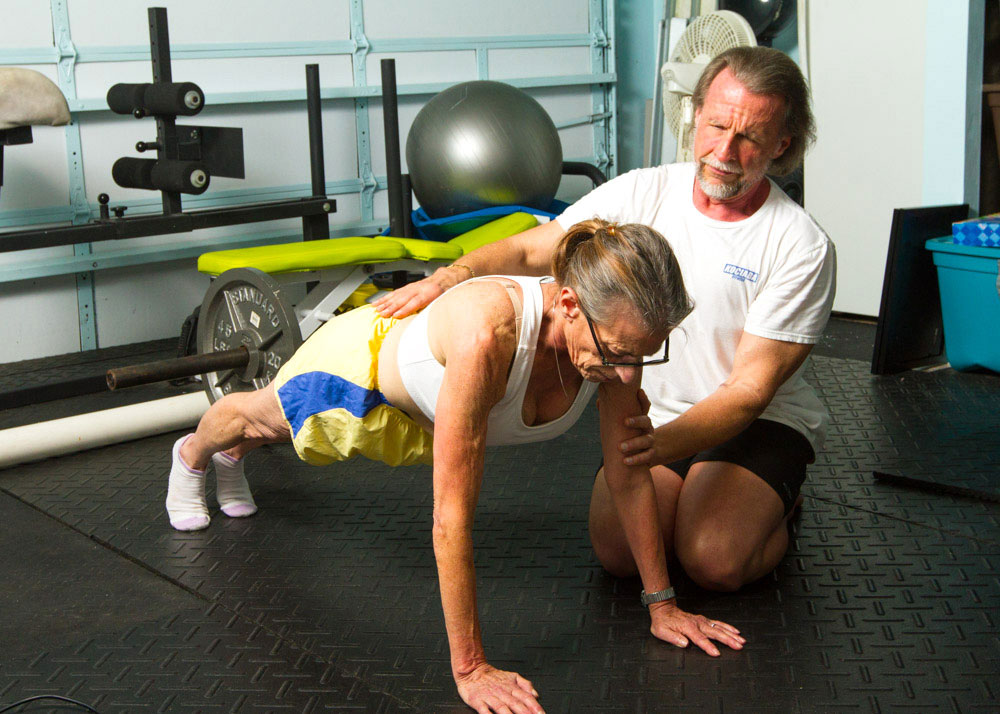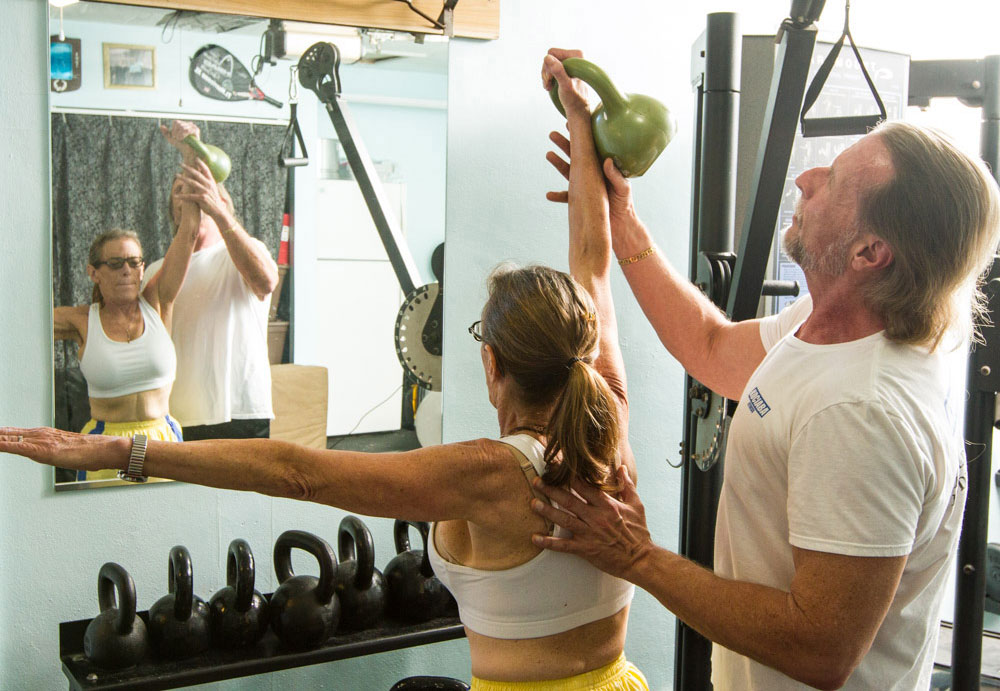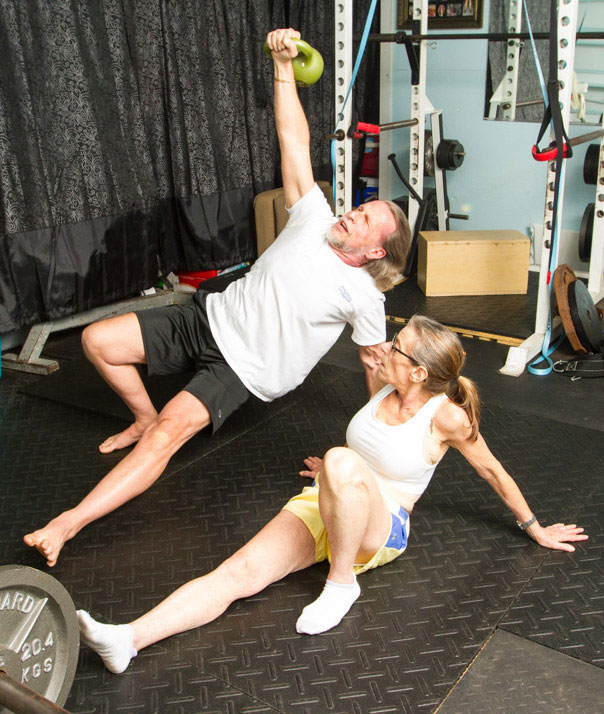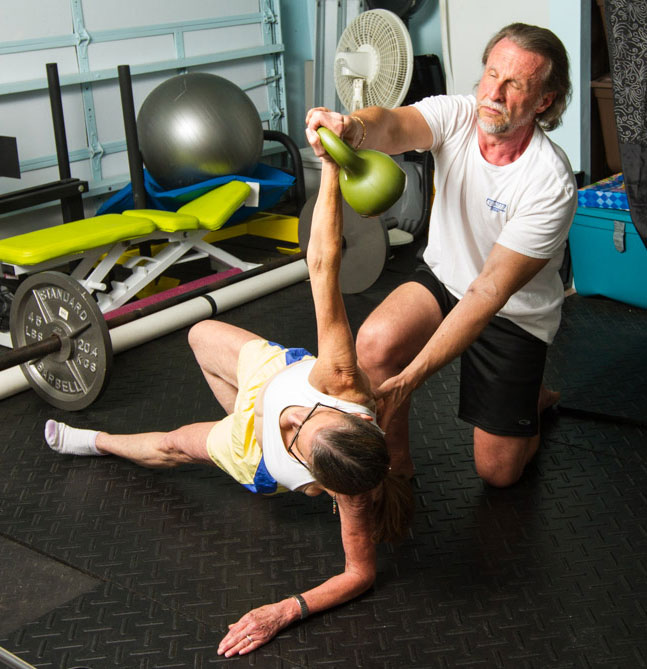Meet Bill Kociaba, the world’s only blind Certified Kettlebell Instructor
By Adrienne Harvey, SrPCC, RKC-TL, CK-FMS

Dragon Door: How did you get started with fitness as an interest and ultimately as your career?
Bill Kociaba: Because of my vision, I didn't go out and play, run, jump or do all the normal things a kid does outside, so I didn’t develop normally. I was physically weak and couldn’t play sports, which was very frustrating since my older brother was an extraordinary athlete.
Since I couldn’t participate, I really wasn’t interested in most sports—but I loved watching professional wrestling. The guys were big and strong like superheroes, and here I was a little fat kid with bad skin and bad eyes who was always getting picked on. I remember seeing Weider ads in the old wrestling magazines. The ad that stood out for me featured Dave Draper and I became obsessed with him.
Around the same time in middle school special needs gym class, we started doing weight training. I was embarrassed to learn that at age 13, I couldn’t even press a 15lb bar over my head! But I kept lifting in class and eventually got stronger. My parents bought me a Sears weight set and it took me several years to gain even normal levels of strength—I was short, fat, and totally uncoordinated!
For my 16th birthday, my parents signed me up at Vic Tanney’s gym. But nobody at that gym knew much more than I did just from reading muscle magazines! After Vic Tanney's burned down under very questionable circumstances, I joined Hollywood Health Center—a real gym—and finally felt like I belonged. Nobody made fun of me. The gym was full of big guys: lifeguards, fire fighters, and construction workers, and they helped me. I quickly learned I had been doing everything wrong. Mr. Massey ran the gym and kind of adopted me. His son, Gene, (who also had a vision issue) had died in a plane crash. Mr. Massey let me train for free. I cleaned the gym to show my appreciation, but it was really just an excuse to be there even more. It was the first time in my life I had ever felt comfortable around other males. I'd always felt super inferior.
Eventually, Mr. Massey sold the gym to three of the members. I’d finished two years of junior college and still didn't know what I wanted to do. A girl I was dating suggested massage school, and because I had read all the magazines and knew a little bit about anatomy it was really easy for me. I ended up tutoring everybody in the class! I also entered a couple of bodybuilding contests. I didn't do very well but was in good enough shape that I could walk on stage and feel proud.
Soon, the three guys who bought the gym were down to one and he was not doing well. So, I asked my parents if we could buy the gym and they indulged me. The gym business is very hard, and this gym was already on shaky ground. But I talked my parents into it. They were both retired and helped me out a lot because they’d both owned small businesses in their lifetimes. My mother even stapled and hot glued the gym equipment upholstery back together.
I soon realized that while I loved the theatrics and showmanship of bodybuilding contests, they were also good advertising. We started running the Hollywood Bodybuilding Championships in 1982 and I continued to run and emcee the shows until 1994. The contests were a lot of fun. I even brought my hero, Dave Draper, down to appear at my first show.
I kept a massage job (at a seasonal hotel) for the first couple of years, so my father would work the day shift at the gym, then I would come in and work at night. I would work full-time at the gym all summer.

Dragon Door: What has kept you passionate about fitness?
Bill Kociaba: I didn't want to get a real job. When I closed the gym in 1999, I went back to massage and training a few people in the little gym in my condo complex’s rec building. I had a brief stint at a travel agency when the economy went bad in 2008. Sometime around 2012, I stumbled onto Brooks Kubick's website which got me excited about training again. I was well over 50 and was just going through the motions because I didn’t know that older guys could still lift heavy. Then while looking on Dave Draper’s website I discovered
Dan John! I also reconnected with Joel Giacobe who used to work at my gym before he went away to college. When Joel went for his masters at Auburn, he worked in Bill Casmeyer's gym. Joel had recently gone through the HKC and was really into kettlebells—soon, Dan John came up in conversation too.
Dragon Door: That leads into my next question—how did you get interested in kettlebells? It’s a very different world than bodybuilding
Bill Kociaba: Yes, a very different world. My friend Mike Bondurant, who passed away a few years ago, owned a gym in Boca. He was a collector and historian of physical culture. He had set up a little "muscle museum" and when he dismantled it, he sold me my first pair of kettlebells. I didn’t have a clue what to do with them.
A 35lb dumbbell isn’t a big deal to me, but a
35lb kettlebell was a different animal. I tried looking online for info, but realized I needed instruction. I’ve now gone through the
HKC twice—the first time was with Beth Andrews and Laurel Blackburn. I had a blast but didn’t pass that weekend because I’d been instructed poorly before the workshop. I had been swinging kettlebells with a big arch in my back for over a year before the HKC.
I also had trouble keeping my arm vertical on the get-up because my shoulders had issues from forty years of bench pressing! Beth and I emailed videos back and forth for weeks after the HKC. Eventually I came up with a way to correct the issue. Since it was proper form to arch on heavy squats and back work for bodybuilding—and I had practiced it that way for more than 30 years—it wasn’t an easy adjustment. I used a bungee cord around my waist and chest to secure a long dowel to my back so it ran from above the top of my head to the back of my knees. This finally kept me from arching my back at the top of swings.

To correct the get-up, I hung a piece of light chain from the kettlebell. If the chain lost contact with my arm, then I knew my arm wasn't perfectly vertical. I also spent a lot of time working on shoulder mobility drills and enforcing that position using the chain. My shoulders will always have issues, my left shoulder in particular, but the get-up has definitely helped. I also do heavy partial get-ups since I am solid until I get past the windmill and the sweep. I can do the sweep and the kneeling position, but standing up from the lunge is really hard for me, because of the balance challenges that come from being blind. For years I had clients in the gym doing lunges and I could never do a lunge to demonstrate it. I was eventually able to demonstrate the get-up well enough to pass the test. But in my own training, I usually just do partial get-ups to the bridge position with a
60lb or
70lb kettlebell.
The second time I went to the HKC was in November 2017 with Dan John. I've interviewed him three times for my podcast and we’ve developed a nice rapport. When I saw he was teaching an HKC in Gaithersburg, Maryland, with a workshop with Tim Anderson of Original Strength the following day, I signed up.
Mike Krivka, hosted the workshops and was amazing! He helped me coordinate my flights and hotel and even got me back and forth to the gym along with Dan. Somehow, I found myself at dinner with Mike, Dan, Tim and
Marty Gallagher after the workshop. That was pretty cool for a little fat kid who never fit in with other males—especially a bunch of alpha males like those guys.
Dragon Door: You mentioned having balance difficulties demonstrating exercises like get-ups and lunges because of being blind. What are some of the techniques you use to coach and instruct your clients?
Bill Kociaba: I was born with poor vision but was able to see and read with a magnifier and watch TV if I sat really close to it. I was what’s called legally blind. I lost the last of my vision around 2008-2009 when I started working in the travel industry. Between the bad economy and not being able to see anything anymore, I figured I was done with training people.

I eventually realized that I could still do it, I just had to be a lot more hands-on as a
trainer. I developed a feather light touch so I can lightly touch someone while they are doing an exercise to monitor their form without interfering with the movement. When I talk to a prospective client, I explain how I coach, and once they understand I have to touch them, it’s usually cool. It’s funny, but the men tend to be more uncomfortable with me touching them than woman once they understand the situation.
Dragon Door: Are you still training clients or leading classes?
Bill Kociaba: Yes, though I recently lost my all-time favorite client. She is an elderly woman I've been working with for almost four years as a post-rehab client. She completed physical therapy after fracturing her pelvis, but felt like she needed to keep working on it. I’ve known her family forever, and her daughter called one day to ask if I knew someone who could train her, so I asked, how about me? I'd never trained an 85-year-old before, but we worked together for four years until she broke her foot and developed some other issues. I taught her how to get off the floor if she ever fell again. That was our big goal and it took a while. It was a regular part of her workout to get down to the floor and back up five times.
I also teach a blind group fitness class. Teaching a group is very challenging especially when most of them can’t see any more than me. The age range of the group is 40s to over 90. It’s a big task to keep the younger ones engaged without overwhelming the older participants. My star in that class is Gladys, who just turned 90! She is an amazing lady who represented Puerto Rico in both the 1960 and 1964 Olympic games as the captain of their volleyball team.
I also have been working with a local charity called Supportabilities. I assist with wheelchair boxing classes, and group fitness classes for multi disabilities including spinal cord injuries, stroke victims and a variety of other issues. One of the guys had had a motorcycle accident, and just wants to be able to get out of the wheelchair and go back to work. I see a lot of value in what I am doing there because the participants aren’t just filling time, they have goals. They want their quality of life to improve!
Dragon Door: What are you working on in your own training?
Bill Kociaba: My training is a mish-mash: I use a TRX a little bit, along with step-ups and pushups with a weighted backpack. I still do squats, military presses, and deadlifts etc. I also use kettlebell swings as my warm-up.
Dragon Door: I noticed that in your
article about Easy Strength and the Jefferson Deadlift.
Bill Kociaba: The best thing about swings is that even after your body gets used to the movement, swings still kick your ass! I use a
rep protocol Dan gave me with sets of 10, 15, and 25 reps.
When I started, 25 reps with a 50lb bell destroyed me, but by the end of four weeks I was doing sets of 50. It blew my mind that I could do 50 swings without it killing me. I just turned 60 and my goal is to be in the best shape of my life this year!
Back